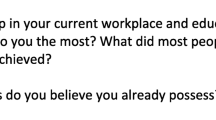Abstract
Qualitative research based on in-depth interviews with seventeen deans of schools of business in US and European universities reveals that morale is higher than has been suggested despite great pressures on the deans' leadership and management abilities. The deans report spending an average of forty-five percent of their time working with external constituents and suffering from excessive workloads. They regard themselves as less powerful than leaders in business whilst being equally accountable financially. They see themselves as facilitators for their colleagues. Whilst acknowledging mistakes and the major scale of challenges ahead, most report a high degree of commitment and enthusiasm. There was no evidence of national cultural differences in organisation or attitudes. None of the deans experienced formal training and development to prepare them for their role. The study may provide some pointers to the possible content and appropriate means of delivering such provision.
Similar content being viewed by others
References
A Business Week Guide: ‘The Best Business Schools’ (1993), Third edition, New York: McGraw-Hill.
Alutto, J.A. (1991). ‘Issues Affecting Business Schools: A Dean's Perspective’, Selections, Autumn, Santa Monica, Graduate Management Admissions Council.
Bennis, W. (1989a). On Becoming a Leader. London: Hutchinson.
Bennis, W. (1989b). Why Leaders can't Lead: The Unconscious Conspiracy Continues. San Francisco: Jossey-Bass.
Bennis W. and Nanus B. (1985). Leaders: the Strategies for Taking Charge. New York: Harper and Row.
Bensimon, E.M. (1989). ‘The Meaning of ‘Good Presidential Leadership’: A Frame Analysis’, Review of Higher Education 12 (2), 107–123.
Bensimon, E.M. (1991). ‘The Social Processes through which Faculty Shape the Image of a New President’, Journal of Higher Education 62 (6), 637–660.
Bensimon E.M. (1993). ‘New Presidents' Initial Actions: Transactional and Transformational Leadership’, Journal for Higher Education Management 8 (2), 5–17.
Birnbaum, R. (1986). ‘Leadership and Learning: The College President as Intuitive Scientist’, Review of Higher Education 9 (4), 381–395.
Birnbaum, R. (1988). How Colleges Work: the Cybernetics of Academic Organization and Leadership. San Francisco: Jossey-Bass.
Birnbaum, R. (1992). ‘Will You Love Me in December as You Do in May? Why Experienced College Presidents Lose Faculty Support’, Journal of Higher Education 63 (1), January/February, 1–25.
Bloom, H., Calori, R., and WooT, P. de (1994). Euro Management: A New Style for the Global Market. London: Kogan Page.
Cowen, R. (1991). ‘The Management and Evaluation of the Entrepreneurial University: The Case of England’, Higher Education Policy 4 (3), 9–13.
Fortune (1994). ‘What is Killing the Business School Deans of America?’ 130 (3), August 8.
Gray, H.L. (1989). ‘Resisting Change: Some Organisational Considerations about University Departments’, Educational Management and Administration 17, 123–132.
Harvey-Jones, J. (1988). Making it Happen: Reflections on Leadership. London: Collins.
Lefell, L. G., Robinson, J F., Harshberger, R. F., Krallman, J. D., and Frary, R. B. (1991). ‘Assessing the leadership culture at Virginia Tech’, in Sherr, L.A. and Teeter, D. J. (eds), Total Quality Management in Higher Education, New Directions for Institutional Research 71, San Francisco: Jossey-Bass.
Lorange, P. (1988). ‘Stimulating Strategic Direction Setting in Professional Groups: The Case of an Academic Department’, Advances in Strategic Management 5, 299–320.
Middlehurst, R. (1989). ‘Leadership and Higher Education’, Higher Education 18, 353–360.
Middlehurst, R. (1993). Leading Academics. Milton Keynes: SRHE/Open University Press.
Neumann, A. (1989). ‘Strategic Leadership: The Changing Orientations of College Presidents’, Review of Higher Education 12 (2), 137–151.
Neumann, A. (1990). ‘Making Mistakes: Error and Learning in the College Presidency’, Journal of Higher Education 61, 386–407.
Neumann, A. and Bensimon, E.M. (1990). ‘Constructing the Presidency: College Presidents'Image of their Leadership Roles: A Comparative Study’, Journal of Higher Education 61 (6), November/December, 678–701.
O'Keefe, D. (1991). ‘Women and Leadership in American Universities’, McGill Journal of Education 26 (3), 303–322.
Wholihan, J.T. (1990). ‘Business Dean Turnover: Causes and Consequences’, Selections, Autumn, Santa Monica, Graduate Management Admissions Council.
Author information
Authors and Affiliations
Rights and permissions
About this article
Cite this article
Bolton, A. The leadership challenge in universities: The case of business schools. High Educ 31, 491–506 (1996). https://doi.org/10.1007/BF00137128
Issue Date:
DOI: https://doi.org/10.1007/BF00137128




